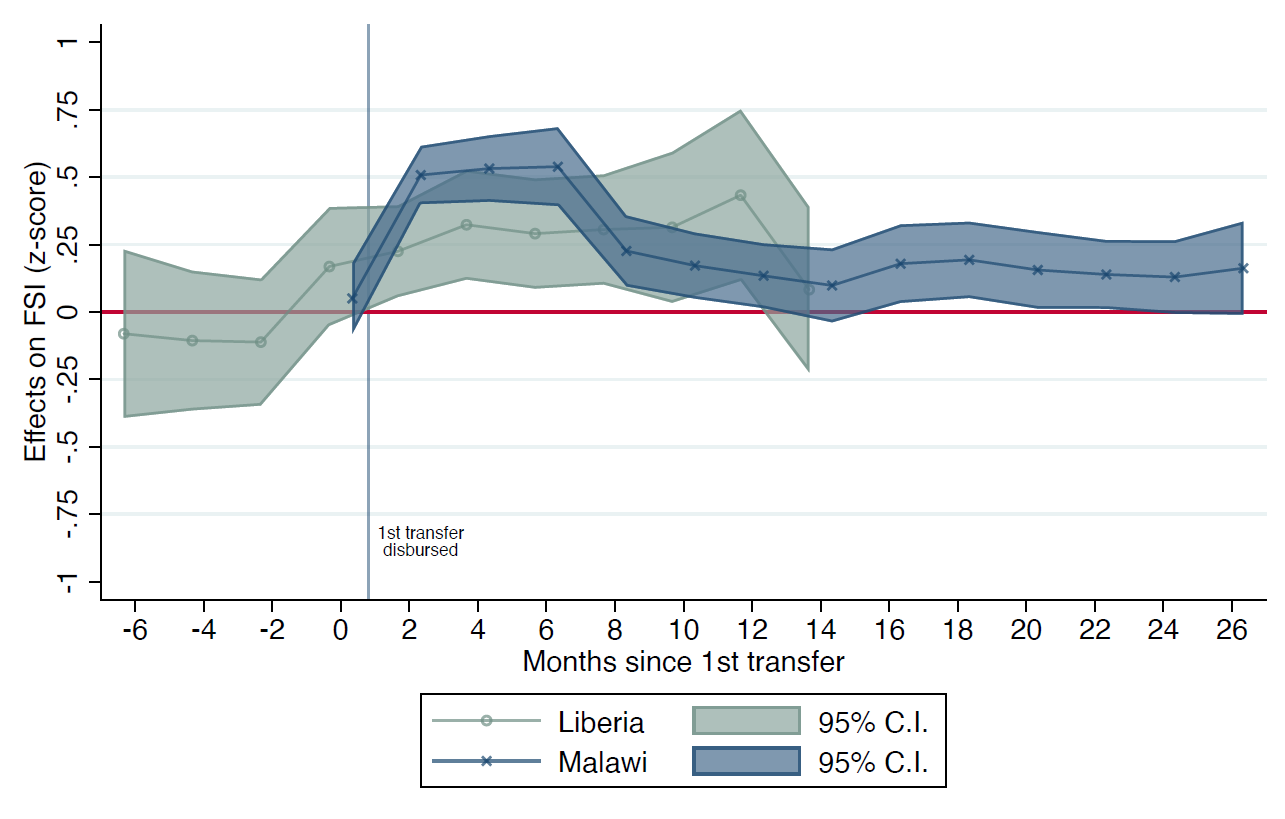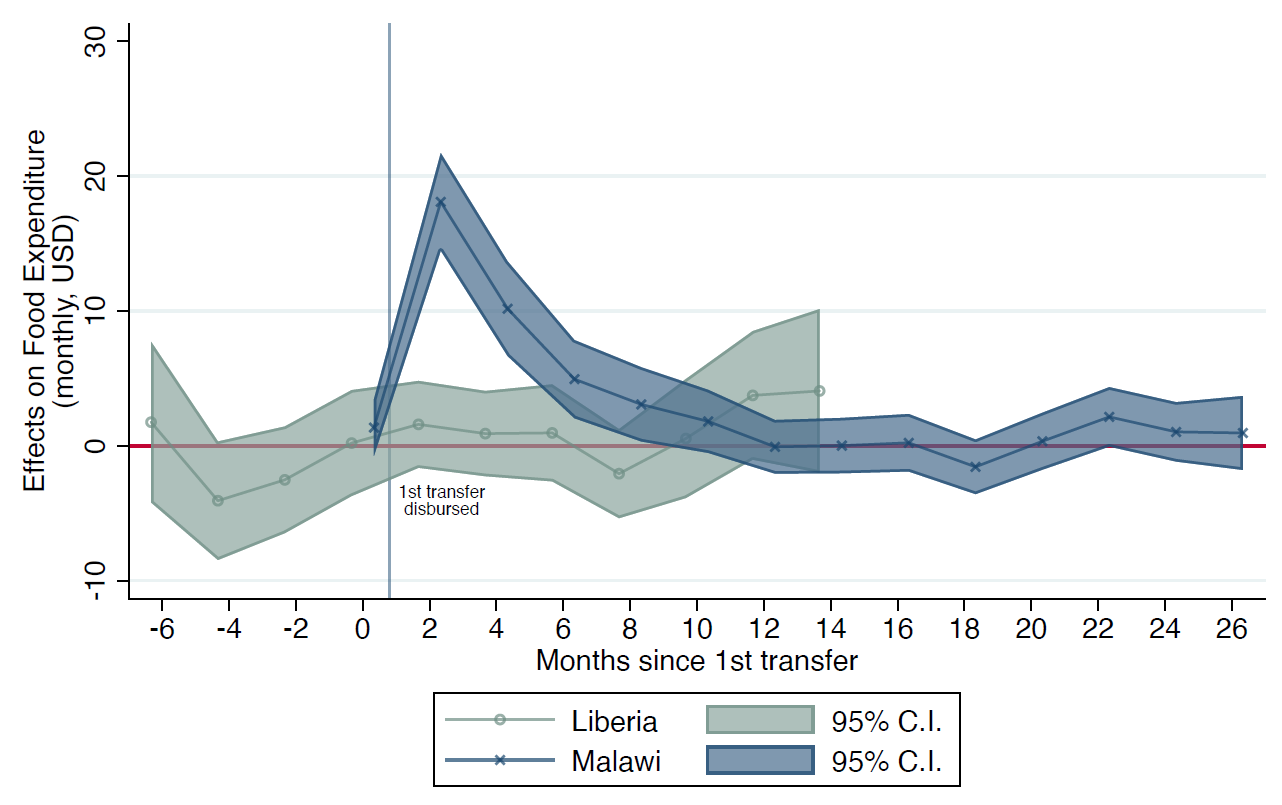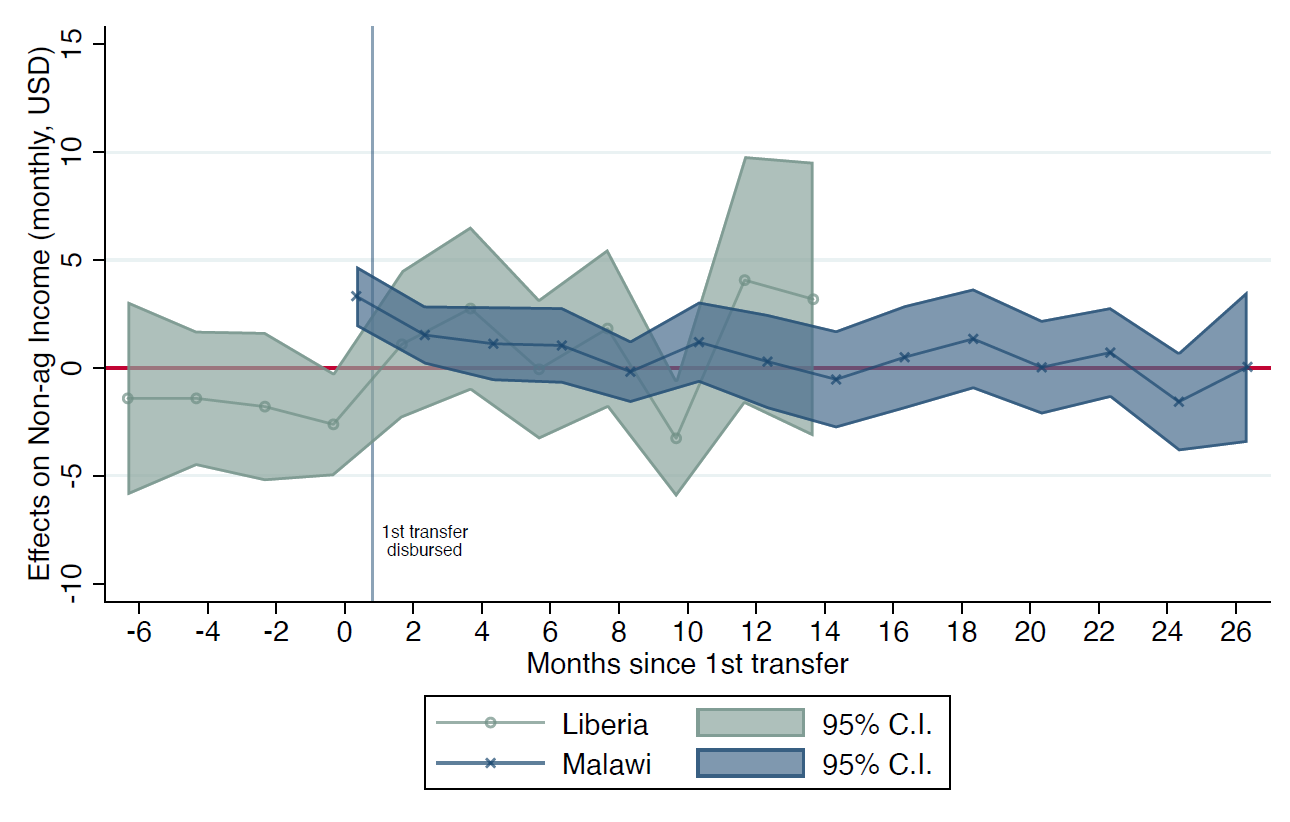
Cash transfers improve food security for up to two years, but without an increase in food expenditures and non-agricultural income
Can one-time cash transfers have lasting effects?
Cash transfers have gained popularity as a policy tool, either as part of government social protection programmes that provide regular assistance to food-insecure households, or as a temporary relief for households that experience shocks. When designing a cash transfer policy, policymakers must make decisions on the duration and frequency of transfers. While a large literature documents the impacts of one-time cash transfers (Blattman et al. 2014, Haushofer and Shapiro 2016, Egger et al. 2022, McIntosh and Zietlin 2021, McIntosh and Zeitlin 2022), there is limited evidence on how long the effects of cash transfers last and how the effects vary over time. Moreover, realising sustained impacts from one-time infusions of cash requires productive investment, and in many contexts, it is unclear whether such productive investment opportunities exist.
Tracking the effects of cash in bi-monthly phone surveys
In our study (Aggarwal et al. 2022), we explore the persistence and the dynamic effects of a randomised cash transfer programme in 300 villages each in Liberia and Malawi, respectively, two of the poorest countries in the world. Half of the villages were assigned to cash transfers, while the other half served as control. Targeting was universal within village: in treatment villages, every household received cash. The value of the transfer was large, averaging US$500, and occurred over a short time frame. These amounts are equivalent to 86% of estimated annual average household expenditures in Liberia, and 126% in Malawi.
We sampled up to 10 households per village for in-person baseline and endline surveys (conducted 18-25 months after cash disbursement). Additionally, we conducted bi-monthly panel phone surveys with 20% of the sample. These phone surveys were designed to track the effects of cash transfers on consumption and income over time, continuing for approximately 14 months and 26 months after the disbursement in Liberia and Malawi respectively.
Persistent impacts on food security but not on expenditure nor on income
Our main outcome is a constructed food security index (FSI), which is comprised of standardised scores of the Household Dietary Diversity Score (HDDS), measured over the preceding 24 hours before interview, the Food Consumption Score (FCS), measured over the preceding seven days, and the Household Hunger Scale (HHS), measured over the preceding month.
Figure 1 shows that the effects of cash on food security persist until the end of the data collection period (i.e. 14 months post-intervention in Liberia and 26 months in Malawi). The sustained impact is large, over 0.3 standard deviations in Liberia (except for the last month), and 0.15-0.2 standard deviations in Malawi. These effect sizes are also confirmed by the endline survey, suggesting that the phone survey sample is empirically representative of the entire survey sample. The figure also shows interesting dynamic patterns. In Malawi, we observe a spike in food security for the first six months, falling by more than half by the eighth month. What is striking is that the effect size remains fairly stable for the following 18 months, suggesting that treatment households are able to maintain the same level of food security for a longer-term horizon. Interestingly, in Liberia, the level of food security is constant from the very start of the transfer.
Figure 1: Food Security Index

Figure 2 shows a quite different dynamic pattern for food expenditures. In Malawi, the peak of food expenditure is about $20 immediately after the transfer, and starts declining fairly quickly by 10 months post-transfer. From that point on, households who received the cash transfer do not spend more on food than control households. In Liberia, there is no initial jump, and the effects of cash on food expenditure remain zero during the study period. In Figure 3, we also do not see any measurable impacts on non-agricultural income, such as wage work or self-employment at any point after the transfer. These limited effects on expenditure and income are in stark contrast to the persistence observed on food security, raising the question as to how food security improves without more spending on food.
Figure 2: Food Expenditure

Figure 3: Income

Where does the sustained food security come from?
While we do not have a definitive answer, we have some evidence on several possible pathways. First, households who received cash transfers increased their investment in livestock. By endline, the treatment group had 22% more in value of livestock in Malawi and 10% more in Liberia. Second, there are large increases in the value of agricultural harvest in both countries in the year after the transfer. Moreover, households who received cash were more likely to engage in farming and to cultivate a staple crop, and also planted more crops. Third, we find an increase in investment in own enterprises.
The persistent effects of cash go beyond consumption
In addition to consumption, we also measure impacts on other proxies for welfare at endline 18-25 months after the first transfers were disbursed. In particular, we find a meaningful increase in psychological well-being (0.34 standard deviations in Liberia and 0.10 in Malawi) and resilience to shocks (0.09 standard deviations in Liberia and 0.12 in Malawi). We also find an eight percentage point reduction of women experiencing intimate partner violence in Liberia. We also examine other secondary outcomes, and find increases in school enrolment and education spending, as well as increases in health investment and spending, primarily in Liberia.
Policy implications
Our paper documents the dynamic patterns of cash transfers for different outcomes and across two different countries. While the size of estimated effects on expenditures attenuates substantially after a few months, our results suggest that a large one-time cash transfer can have a lasting effect on food security. Our analysis also points to the importance of measuring food consumption carefully: while we find no effects on food expenditures, we do find lasting effects on food security. We did not directly measure food consumption in our study, but we recommend that other researchers do so in future work. Finally, our work suggests that home production is likely an important channel via which cash transfers may have sustained impacts in rural economies, and suggests the need to carefully measure these channels.
References
Aggarwal, S, J Aker, D Jeong, N Kumar, D S Park, J Robinson, and A Spearot (2022), “The Dynamic Effects of Cash Transfers: Evidence from Rural Liberia and Malawi”, Working Paper.
Blattman, C, N Fiala, and S Martinez (2014), “Generating Skilled Self-Employment in Developing Countries: Experimental Evidence from Uganda”, The Quarterly Journal of Economics 129(2): 697–752.
Egger, D, J Haushofer, E Miguel, P Niehaus, and M W Walker (2022), “General Equilibrium Effects of Cash Transfers: Experimental Evidence from Kenya”, Econometrica 90(6): 2603-2643.
Haushofer, J and J Shapiro (2016), “The Short-term Impact of Unconditional Cash Transfers to the Poor: Experimental Evidence from Kenya”, The Quarterly Journal of Economics 131(4): 1973–2042.
McIntosh, C and A Zeitlin (2021), "Youth Employment and Productivity: Medium-term Experimental Evidence from Rwanda", Working Paper.
McIntosh, C and A Zeitlin (2022), “Using Household Grants to Benchmark the Cost Effectiveness of a USAID Workforce Readiness Program”, Journal of Development Economics 157, 102875.







